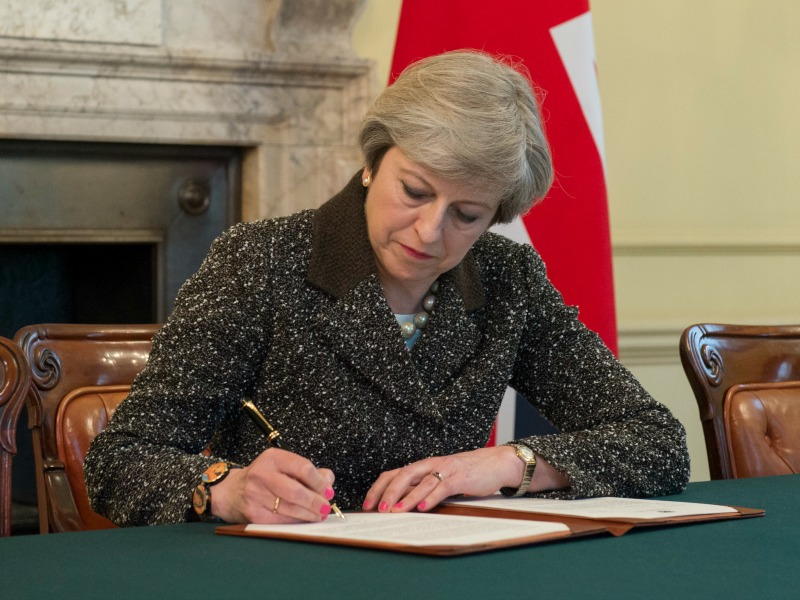Finsbury 29 Mar 2017 // 3:41PM GMT

Prime Minister Theresa May has formally notified the EU of the UK’s intention to leave under the Article 50 exit process of the European Treaties – a process that was never intended to be actually used.
This notification starts the clock on a two-year period during which the UK will have to negotiate a withdrawal agreement with the EU. It is the first time such a negotiation is carried out, so both negotiating sides will adjust their positions and tactics as the process is under way. In addition, there is no legal duty on the EU to negotiate a future trade and security relationship with the UK within this two-year process.
If the UK fails to secure an agreement with the EU within this timeframe, it will fall out of the EU onto the default position of a trading relationship based on World Trade Organisation (WTO) rules which would involve tariffs on some goods, burdensome checks at the UK-EU border and limited arrangements allowing UK firms to sell their services into the EU.
This note will set out what could happen next, key uncertainties and our advice for businesses.
What happens next?
Both the EU and the UK have used the past months to align their negotiating positions, giving a sense of the (often conflicting) red lines and priorities.
The UK wishes to conclude a withdrawal agreement and a future trade agreement by March 2019. If the latter cannot be finalised within the two year window, Theresa May has said she wishes to agree “a phased process of implementation” in which to secure extra time to adjust.
The EU has committed to publish key details on its negotiating position throughout the two year process. The EU’s Chief Negotiator, Michel Barnier, has written that his priority will be to achieve clarity particularly regarding the mobility of people, to settle the UK’s “divorce bill” or financial settlement and to solve the Northern Ireland border issue in a way that protects the peace process. Only then will the EU consider discussing a future trading relationship with the UK within the two year window.
Potential timeline:
- 29 March 2017: UK notifies the EU of its intention to withdraw under Article 50.
- 31 March 2017: draft EU27 negotiation guidelines – i.e. the EU27’s agreed negotiating position – circulated by the European Commission to member state delegations.
- 29 April 2017: Council of the EU27 leaders meet to agree the guidelines formally.
- 7 May 2017: second round of the French presidential election.
- 14 May 2017: new French president formally takes office.
- End of June 2017: EU27 agree negotiating directives developing a more detailed negotiating mandate for the Commission. There is not likely to be any published detail on how the EU’s position could affect key industrial sectors until this point.
- 24 September 2017: German federal elections. The process of forming a new government could take weeks if the result is unclear.
- October 2018: Michel Barnier’s deadline for finishing negotiations before having it ratified by the Council of the European Union (with a minimum support of 20 out of 27 member states), the EU Parliament (simple majority), and approved by the UK Parliament until March 2019.
- March 2019: the UK formally leaves the EU, with or without an agreement.
- May 2019: European Parliament elections.
- After that: negotiations around a Free Trade Agreement could drag on for years. It would need to be approved by all member states and the European Parliament, as well as ratified by some national and regional parliaments in the case of mixed trade agreement (think Wallonia in the case of the EU’s trade agreement with Canada).
This timeline therefore remains highly provisional. The two-year deadline could theoretically be extended if the European Council and the UK agree on this, although there seems to be little appetite on both sides as of today.
The negotiation could collapse at any time if relations between the parties sour quickly. That would mean the UK defaulting onto a WTO trading relationship with the EU without an agreement.
What the UK will ask for
Theresa May set out the UK’s broad position in January. She confirmed:
- The UK will end its Single Market membership and seek to replace it with either a UK-EU comprehensive free trade agreement, or, failing that, walk away in 2019 with no agreement by falling back on the default World Trade Organisation (WTO) relationship with the EU;
- The UK will end its full membership of the EU’s Customs Union and seek tariff and impediment-free goods trade through some form of special customs deal;
- Her red lines in the negotiation will be ending the application of the EU’s right of free movement of people in the UK and withdrawing the UK from the jurisdiction of the Court of Justice of the European Union (CJEU);
- The UK will seek to negotiate a limited “phased process of implementation” of the new arrangements once the formal Article 50 process has ended. David Davis, Secretary of State for Exiting the European Union, has since stated that the UK envisages this period lasting three to five years;
- The UK will seek an early agreement on the rights of EU citizens currently residing in the UK and vice versa; and
- The UK will no longer pay “vast” sums of money into the EU’s budget, but the Prime Minister is prepared to contribute to EU programmes in which the UK will continue to play a part.
How the EU27 countries are likely to react
In stark contrast to the UK, Brexit has slipped down the agenda in key EU capitals over the last few months from being a widely reported event with significant consequences to a relatively lower priority issue. Its presence in media and political debate has waned. Trump’s election and populism in Europe have overshadowed Brexit.
The Commission’s Chief Negotiator Michel Barnier and EU leaders have been broadly clear on their position over the last few months:
- The outcome of this negotiation process must show that being a member of the EU comes with more benefits than not being a member.
- Theresa May and DExEU Secretary David Davis wish to negotiate a withdrawal agreement and a future trading relationship in parallel. By contrast, the EU wishes to negotiate these sequentially.
- Barnier has written that the European Commission is only prepared to begin negotiations on a future trading relationship once there has been agreement on a) the UK’s financial settlement with the EU, b) an agreement on the rights of EU citizens currently in the UK and vice versa and c) a solution to potential problems at the Republic of Ireland/Northern Ireland UK border so that the peace process is not threatened.
- Barnier has also said that the EU wishes to conclude “an ambitious free-trade agreement, provided that it ensures fair competition and guarantees high environmental, social and consumer protection standards. It could also include co-operation in several fields, especially in security and defence.”
- Theresa May has made clear that she is prepared to walk away from negotiations with “no deal”, because that would be better for the UK than a “bad deal”. Michel Barnier has responded by saying that this outcome would be worse for the UK than the EU.
While all member states may raise concerns if an existential issue for them arises, the strength and cohesion of the EU’s position will to a large extent depend on the degree of agreement between the German and the French Government. There could be surprises.
If Marine Le Pen wins the French election it will be a factor putting the cohesion of the EU 27 strongly to the test. The consequences are unpredictable.
Key uncertainties
While a reasonable deal for both sides is possible, to say there are major uncertainties is a grave understatement:
- Will negotiations fall apart rapidly over a row about how much the UK should pay the EU through its financial settlement or will this take so long to agree that there is no time left to discuss a free trade agreement? The Commission has talked about a £50 billion bill. Reports say Foreign Secretary Boris Johnson and International Trade Secretary Liam Fox are only prepared to pay £3 billion. Backbench Conservative MPs will have little patience for a large bill.
- Will Conservative Leave MPs force Theresa May to walk away with no deal and default onto a UK-EU relationship based on WTO rules in 2019 if they do not like the look of the compromises involved in a deal?
- Will the UK and the EU manage to agree to a transitional implementation phase between the old and new relationships and if so, for how long? Will EU rules and the jurisdiction of the CJEU apply in full during this period? Or will the jurisdiction of the CJEU formally end during a transition period, but with a partial role?
- Will the EU agree to a special Customs Union deal with the UK to enable tariff and impediment-free goods trade? There is little benefit in the EU agreeing to this without the UK appearing to pay some form of price.
- Even if the UK uses the next two years to prepare for any problems caused by falling out of the EU onto WTO rules, will the EU prepare so there are no problems on its side of the border?
- Exactly what level of access will financial services firms have under any agreement and what level of scrutiny will the EU demand in return?
- Exactly what rights will EU citizens have to work and live in the UK and vice-versa?
- What EU programmes will the UK continue to participate in post-Brexit, if any?
How likely is a ‘no deal’ scenario?
A “no deal” scenario is possible. While not the EU’s preferred outcome, it believes that this would be worse for the UK.
Conservative Leave MPs have briefed friendly journalists that they believe there is a 50-50 chance of no deal. Boris Johnson has said that the UK falling back on WTO rules in 2019 would be “perfectly ok”.
This is telling.
The number of Conservative MPs who have made fighting a campaign to leave the EU their number one cause over the last 25 years outweighs the size of Theresa May’s majority in the House of Commons and is high enough to trigger a leadership election under the internal Conservative Party rules.
For them, leaving the EU without a deal is better than either compromising too much or signing up to a lengthy transitional period in which the jurisdiction of the CJEU applies in full and during which time the Brexit decision could be reversed.
Given that the rough parameters of a deal would emerge when a draft deal is sent for the European Parliament’s ratification, Conservative MPs could quickly put pressure on Theresa May to walk away.
That, combined with the electoral threat UKIP poses should they credibly be able to claim “betrayal” if the Prime Minister agrees to one compromise too many, makes a no deal scenario a very real possibility.
Advice for businesses
Prepare
- Companies should begin scenario planning and adapt business plans for a deal or no deal basis – including a WTO relationship with the EU.
- Work out what companies need to see in a future UK-EU free trade agreement to maximise growth.
- When defining their engagement strategy, companies should be aware 1) of the increasingly divergent public perception of Brexit in national media in the different member states 2) of the fact that business interests have to be put in the broader political context of negotiation priorities.
Engage
- Companies should actively engage in the decision-making process both with the UK Government and, crucially, in Brussels and key member states, especially Berlin, during the negotiations to ensure the best outcome for the company and the company’s sector.
- Identify where there is common ground between the UK and the EU in the company’s sector and make the argument on both sides of the Channel.
- The negotiating parties are interested in learning about the challenges but particularly in hearing about solutions to problems for business. There is therefore a clear window of opportunity for a company to explain how their business is affected. Companies should help the European Commission, member states’ governments – including the UK Government – to find solutions to ensure continuity post Brexit, including in a no deal scenario.
Evaluate potential trade opportunities
- Where relevant, companies should evaluate the risks and opportunities of potential trade deals between the UK and non-EU countries.
- After the UK leaves the EU, businesses based in the UK will no longer have access to the EU’s free trade deals with key economies like Canada and South Korea. Where companies are affected, they should prioritise engaging with the UK Government and potentially the third country government to ensure existing market access is replicated or even improved in the replacement free trade agreement.
By Adam Atashzai, a Partner at Finsbury in London, Biancastella de Angelis, a director at Hering Schuppener who is based in Brussels, and Matthis Kaiser, a director at Hering Schuppener who is based in Berlin.
Photo Credit: © Crown Copyright 2017


































.jpg)





---copy.jpg)









